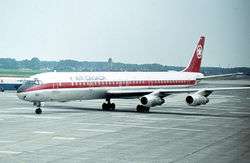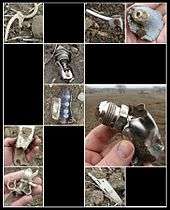Air Canada Flight 621
 An Air Canada McDonnell Douglas DC-8 similar to the aircraft that crashed. | |
| Accident summary | |
|---|---|
| Date | July 5, 1970 |
| Summary | Explosion and crash caused by crew error |
| Site | Brampton, Ontario |
| Passengers | 100 |
| Crew | 9 |
| Fatalities | 109 (all)[1] |
| Injuries (non-fatal) | 0 |
| Aircraft type | McDonnell Douglas DC-8-63 |
| Operator | Air Canada |
| Registration | CF-TIW |
| Flight origin | Montreal-Dorval Int'l Airport |
| Stopover | Toronto International Airport |
| Destination | Los Angeles Int'l Airport |
The Air Canada Flight 621 crash near Toronto Pearson International Airport, took place on July 5, 1970, when an Air Canada Douglas DC-8, registered as CF-TIW, was attempting to land. It was flying on a Montreal–Toronto–Los Angeles route.[2]
All 100 passengers and 9 crew on board were killed, and at the time it was Canada's second deadliest aviation accident.[2][3]
History
Captain Peter Hamilton and First Officer Donald Rowland[4] had flown on various flights together before, and had an ongoing discussion on when to arm the ground spoilers.[3] They both agreed they did not like arming them at the beginning of the final approach, as specified in the checklist, fearing it could lead to an inadvertent spoiler deployment. The captain preferred arming them on the ground, while the copilot preferred arming them during the landing flare.
Executed just above the runway, the flare arrests the aircraft's descent just prior to touchdown. By raising the aircraft's nose (pitching up) lift momentarily increases, reducing the descent rate, and allows the main wheels to gently contact the runway. During the flare, pilots retard the throttles to idle to reduce engine thrust. A squat switch in the main landing gear detects the touchdown and automatically deploys the spoilers, if armed. This destroys any remaining lift and helps the aircraft slow down.
The pilots made an agreement that, when the captain was piloting the aircraft the first officer would deploy the spoilers on the ground, as the captain preferred, and when the first officer was piloting the aircraft the captain would arm them on the flare as the copilot preferred.[3]

On this particular instance, the captain was piloting the landing and said, "All right. Give them to me on the flare. I have given up."[3][5] This was not their usual routine. Sixty feet from the runway, the captain began to reduce power in preparation for the flare and said, "Okay" to the first officer. The first officer immediately deployed the spoilers on the flare, instead of just arming them. The aircraft began to sink heavily and the captain, realizing what had happened, pulled back on the control column and applied full thrust to all four engines.[3] The nose lifted, but the aircraft still continued to sink, hitting the runway with enough force that the number four engine and pylon broke off the wing. There was also a tail strike at this time. Realizing what he had done, the first officer began apologizing to the captain. Apparently unaware of the severity of the damage inflicted on the aircraft, the crew managed to lift off for a go-around, but the lost fourth engine had torn off a piece of the lower wing plating and the aircraft was now trailing fuel, which ignited. The first officer requested a second landing attempt on the same runway but was told it was closed due to debris and was directed to another runway.[5]
Two and a half minutes after the initial collision, the outboard section of the right wing above engine number four exploded, causing parts of the wing to break off. Six seconds after this explosion, another explosion occurred in the area of the number three engine, causing the pylon and engine to both break off and fall to the ground in flames. Six and a half seconds after the second explosion, a third explosion occurred, destroying most of the right wing, including the wing tip. The aircraft then went into a violent nose dive, striking the ground at a high velocity of about 220 knots (407 km/h) and killing all 100 passengers and the nine crew members on board.[3]
The mishap was the first Air Canada accident involving fatalities since November 1963, when another DC-8, Flight 831, also bound from Montreal to Toronto, crashed with a loss of 118 lives. Wreckage, body parts, bits of clothing and personal effects were strewn for more than 90 metres (100 yards) beyond the impact spot. The plane dug a furrow eight or ten feet deep, less than 60 metres (200 feet) from the home of the Burgsma family, in which 10 persons lived, with the crash explosion blowing in their windows.
The crash occurred in a farm field located near Castlemore Road and McVean Drive in Brampton, Ontario. The memorial and witness accounts at the time report the crash site was at Woodbridge. This was because in 1970, prior to urban sprawl and changes in municipal boundaries, the site was closer to Woodbridge than Brampton.
Investigation
A Board of Inquiry published their official report on January 29, 1971. The accident was attributed to pilot error.[6] In the official report, eight recommendations were provided, including that the activating lever for the spoilers should be designed in such a way that it could not be activated while the DC-8 is in flight, that the manufacturer should reinforce the structural integrity of the DC-8's wings and fuel tank, and that Air Canada training and operating manuals should clarify the operating procedures around spoiler arming and deployment.[7]
Aftermath
Recovery and identification of bodies proceeded slowly after the crash due to the need to excavate the crash crater to a significant depth. More than 20 of the passengers were United States citizens, all of them listed as being from Southern California.
On July 30, 1970, 49 identified and 3 non-identified victims were buried at Mount Pleasant Cemetery and in May 1971 an obelisk and stone monument was erected (plot 24-1) at the grave site with all 109 names inscribed on it.[8] In 1979 Air Canada also added an additional memorial at Mount Pleasant Cemetery.[9]
Memorial Garden dedication in 2013
Since the crash the surrounding area of the crash site itself has experienced significant residential urbanization. In January 2007, the landowners in conjunction with the property developers filed an application to designate a section of the crash site as a cemetery and memorial garden.[10] On July 7, 2013, the memorial was officially opened at the site [11] near Degrey Drive and Decorso Drive in present-day Brampton.[12]
The small memorial park, approximately a third of a hectare in size (~3,000 M2) contains lilacs and 109 markers of polished white granite arranged in a random configuration within a bed of black granite paving stones. A polished black granite plaque noting all the victims' names is mounted on a large pink granite boulder. A Candevcon Corporation spokesman, Diarmuid Horgan, said at its official opening that it was hoped the park would help victims' families find peace.[6][13][14]
References
- ↑ "Brampton Remembers Flight AC621". brampton.ca. Retrieved September 6, 2011.
- 1 2 "40th anniversary of Flight 621 crash". Brampton Guardian. Retrieved September 6, 2011.
- 1 2 3 4 5 6 Aviation Safety Network Accident Description, CF-TIW, Aviation Safety Network Database, 2013.
- ↑ "What was on the CVR Tapes?". Friends of Flight 621. Archived from the original on May 28, 2008. Retrieved June 29, 2010.
- 1 2 CVR transcript Air Canada Flight 621 - 05 JUL 1970, Aviation Safety Network Database, 2013.
- 1 2 Dedication of memorial at site of 43-year-old Air Canada plane crash, The Canadian Press, July 7, 2013. Retrieved from GlobeandMail.com July 7, 2013.
- ↑ Canada Board of Inquiry into the Accident at Toronto International Airport, Malton, Ontario, to Air Canada DC8-CF-TIW aircraft on July 5, 1970, AMICUS No. 21795471 Monograph, Libraries and Archives Canada website.
- ↑ "Air Canada Flight 621 Memorial". Mount Pleasant Group. Retrieved July 5, 2013.
- ↑ Alexander, Julia. Brampton memorial garden dedicated to Air Canada victims, Toronto Sun, July 7, 2013. Retrieved from TorontoSun.com July 8, 2013.
- ↑ "Brampton Remembers Flight AC621". City of Brampton. Retrieved April 18, 2012.
- ↑ http://maps.google.ca/maps
- ↑ Brampton Memorial Dedicated to Air Canada Crash Victims, The Canadian Press, July 7, 2013.
- ↑ Families find closure as air crash memorial site unveiled after 43 years, The Canadian Press, July 7, 2013. Retrieved from TimesColonist.com on July 8, 2013.
- ↑ Canadian Press (July 4, 2013). "Horrific Air Canada crash gets permanent memorial site after 43 years". CTV News. Toronto. Archived from the original on July 5, 2013. Retrieved July 5, 2013.
Further reading
- A chance to say goodbye: Memorial site of horrific Air Canada crash prompts reader memories, The Globe and Mail, July 5, 2013. Retrieved from GlobeandMail.com July 7, 2013.
- Fishman, Lynda (2010). Repairing Rainbows: A True Story of Family, Tragedy and Choices. Toronto: Self Published. ISBN 978-0-9866074-0-0.
A book from the point of view of one of the victims' surviving children.
External links
- Accident description at the Aviation Safety Network
- Cockpit voice recorder transcript
- Official accident report (Internet Archive) - Webcitation archive
- Friends of Flight 621 via the Internet Archive
- Super70s.com report on Flight 621
- Air Canada Flight 621 Memorial at Find a Grave
- Location of Flight 621 Memorial Garden dedicated in Brampton on July 7, 2013 Google Maps diagram created August 20, 2013.
- Location of Flight 621 Memorial Garden dedicated in Brampton on July 7, 2013 Google Maps diagram created August 20, 2013. Illustration by D. Summerlee.
Coordinates: 43°46′47″N 79°41′28″W / 43.7798°N 79.6912°W